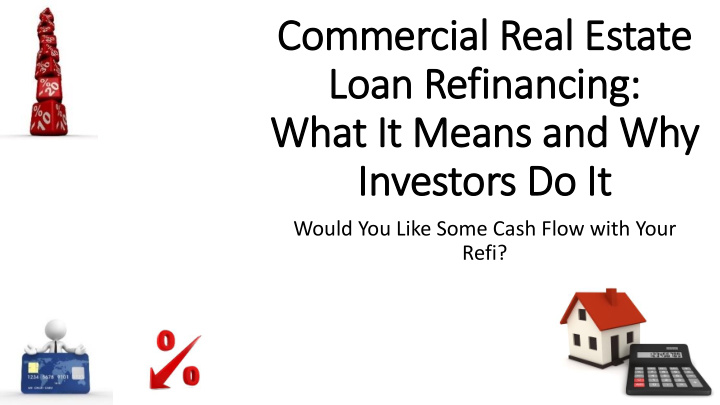



Commercial Real Estate Loan Refinancing: What It Means and Why Investors Do It Would You Like Some Cash Flow with Your Refi?
Question That Came in the Other Day… “Can you explain, in layman’s terms, why you often assume that Debt gets refinanced in real estate deals?” “Also, why is the amount of new Debt raised often different from the amount of existing Debt repaid?”
The Short Answer • Equity Investors complete refinancings to boost their returns in real estate deals – and because it’s in everyone’s best interest • “Refinancing” means repaying existing Debt – almost all real estate deals involve Debt – by raising new Debt (think of it as “replacing” existing Debt) • A Refinancing boosts returns for the Equity Investors by reducing the interest expense and/or letting them earn back some of their initial investment before the exit (sale of the property) • Some of the same reasoning applies to dividend recaps in LBO models for traditional companies (but not lower interest)
Why Refinance? • Reason #1: Interest rates have fallen, or the property’s credit profile has changed, and the Equity Investors can get lower rates • Example: Interest rates fell from ~5% to ~4% in the past year, so if there’s $10 million of Debt, the Interest Expense could fall from $500K to $400K • This might sound small, but if the property’s value is $15 million, and its Yield is 5%, this might increase cash flow from $250K to $350K • Reason #2: The property’s value has increased, so by refinancing at the same “Loan to Value” (LTV) Ratio, the sponsor can earn back some of its initial investment early – before the exit
Why Refinance? • Example: An investor pays $10 million for a property that generates $600K in Net Operating Income (NOI) in Year 1 (6% Cap Rate) • LTV: 70%, so the investor uses $7 million of Debt to fund the deal • Year 3: The property’s NOI has increased to $650K, and market conditions have stayed about the same • So: Assuming the same 6% Cap Rate, the property is now worth $650K / 6% = $10.8 million • New Debt: $10.8 million * 70% = $7.6 million
Why Refinance? • So: $7.6 million of New Debt… but the old Debt balance was only $7 million! Might be even less if there’s amortization • Gain: That extra $600K (or more!) goes to the Equity Investors, and they get a positive cash flow of $600K instead of waiting until the exit for everything • Example in Excel: We acquire this hotel in Darwin, Australia for an 8.80% Cap Rate; NOI = ~$4.7 million, so $54 million purchase price • Debt: 75% LTV Acquisition Loan and 10% LTV Mezzanine for 85% Total LTV; ~$45.7 million Debt, including impact of transaction fees
Why Refinance? • Deal: We operate the hotel normally for 2 years, and then renovate it over 2 years, spending ~$6.7 million total • Year 4: The hotel’s Forward NOI has increased to $6.3 million, which means a $70.5 million value at a 9.00% Cap Rate • So: We use a 75% LTV, raising a Permanent Loan of $52.9 million to repay the ~$44.4 million of Acquisition Loan + Mezzanine (75% is *less than* the initial 85% LTV – not a very aggressive deal) • And: That $8.5 million “extra” goes to the Equity Investors (it’s a bit less due to the financing fees)
Why Refinance? • WITHOUT the Refinancing : The 5-year IRR would be 17.9% • WITH the Refinancing: The 5-year IRR increases to 19.1% • This may seem like a small difference, but the benefits can be much greater – especially if Cap Rates also fall or we use the same LTV for the acquisition and the refinancing • And… if something’s available to boost returns, why would you not take advantage of it?
Why Refinance? • Reason #3: The terms of the Debt require a refinancing • Why: Different lenders target different risk / potential returns… Construction Lenders don’t want to stay on board once a property is built and stabilized • Bridge Loans: Same idea → Lenders want to invest for the short term, earn a higher interest rate, and then redeploy capital • So… some lenders require the property owners to refinance when certain conditions are met, or when there’s a “change of control” (i.e., someone new acquires the property)
The Downsides of Refinancing • QUESTION: Is there any reason not to refinance a CRE loan? • Answers: If a property’s value has fallen and no refinancing is required, it probably won’t happen; if interest rates have risen, it’s also less likely • A Refinancing may also increase the chances of default, especially if the Interest Coverage Ratio and DSCR fall • Finally, sometimes it’s tricky to determine the property’s value and appropriate amount of Debt, especially in developments where it takes time for the property to stabilize – could backfire!
Recap and Summary • Why Refinance? To boost returns! • Idea: Take a Construction Loan or Bridge Loan in a real estate deal and replace it with new Debt once the property stabilizes or increases in value • Result: The Equity Investors earn back some of their proceeds early and get a lower interest rate in the process • And: The lenders are pleased since they earn higher interest at first, and then exit once the property stabilizes – so they can deploy their capital elsewhere
Recommend
More recommend